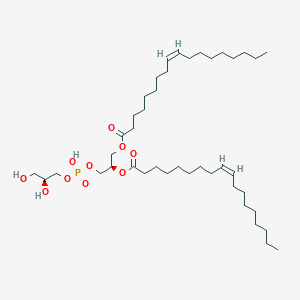PG(18:1(9Z)/18:1(9Z))
PG(18:1(9Z)/18:1(9Z)) is a lipid of Glycerophospholipids (GP) class. Pg(18:1(9z)/18:1(9z)) is associated with abnormalities such as Neonatal hemochromatosis, Renal tubular disorder, Hereditary pancreatitis and UDPglucose 4-epimerase deficiency disease. The involved functions are known as Genetic Translation Process, Regulation, Saturated, enzyme activity and Cytokinesis. Pg(18:1(9z)/18:1(9z)) often locates in Membrane, soluble, Tissue membrane, membrane fraction and Thylakoid Membrane. The associated genes with PG(18:1(9Z)/18:1(9Z)) are COIL gene, P4HTM gene, GRAP2 gene, Integral Membrane Proteins and synthetic peptide. The related lipids are Liposomes, Fatty Acids, Sphingolipids, DOPE and 1,2-oleoylphosphatidylcholine.
References related to functions published in Biochim. Biophys. Acta
| PMID | Journal | Published Date | Author | Title |
|---|---|---|---|---|
| 27806910 | Biochim. Biophys. Acta | 2017 | McDonald C et al. | Structure and function of PspA and Vipp1 N-terminal peptides: Insights into the membrane stress sensing and mitigation. |
| 27480803 | Biochim. Biophys. Acta | 2016 | Harrison PL et al. | Phospholipid dependent mechanism of smp24, an α-helical antimicrobial peptide from scorpion venom. |
| 27085977 | Biochim. Biophys. Acta | 2016 | Shinoda W | Permeability across lipid membranes. |
| 25445669 | Biochim. Biophys. Acta | 2015 | Jobin ML et al. | The role of tryptophans on the cellular uptake and membrane interaction of arginine-rich cell penetrating peptides. |
| 25306964 | Biochim. Biophys. Acta | 2015 | Tavano R et al. | The peculiar N- and (-termini of trichogin GA IV are needed for membrane interaction and human cell death induction at doses lacking antibiotic activity. |
| 27301269 | Biochim. Biophys. Acta | 2016 | Kawatake S et al. | Evaluation of diacylphospholipids as boundary lipids for bacteriorhodopsin from structural and functional aspects. |
